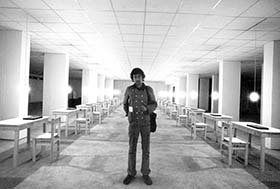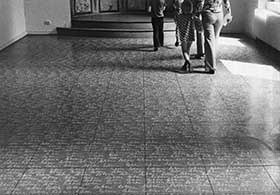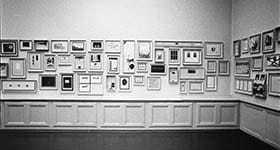1970s
Text by Jochen Gerz


Poetry after Auschwitz? Kids after Auschwitz? Quite a few academic papers are written about Adorno’s sentence. What does he mean by this? Nobody quotes the people who do not write. Poetry? Can you speak about the sacrifice of poetry after Auschwitz? What about children? What about the sacrifice of children? No more kids after Auschwitz. Founding cooperative child daycare centres (crèches sauvages) in occupied spaces of the Censier and Jussieu faculties in Paris. You find people (not among your friends), Algerians need a cheap place for their babies, they don’t ask questions. Autogestion. Half a day of your precious time per week for 3 francs a day (€0.45). We do not need help. We do not need to talk a lot about babies (of course we talk about education). We need to talk about the parents.
The babies do not come alone. They have parents. What about them? What about himself? Can he speak about himself? Is it possible to act and to doubt? Is it possible to do both?

Growing awareness that he wants to talk about something. Something is something else. Churchill is a clever man. Auschwitz is not Auschwitz. He speaks in 1946 of the need for oblivion “if we want to push ahead”. Is this the reason he loses his job? What he means is: Auschwitz is over; Auschwitz will be all over, be prepared. What he probably imagines is the continuously growing importance of new media, their presence, their alienating attraction and power. He talks of the (European) need to unite, the (European) need to invent in the American century. Memory will be the memory of tomorrow.

Critique of media. To critique media means to use media. Simultaneously. Criticism establishes the facts. Does it acknowledge its delay? Where have you been, innocents? Contradiction is a prerequisite for being an artist, for doing art. Mail Art: In a bourgeois society, authenticity, for an artist, means to be unauthentic and say so. First use of a computer in the installation: These words are my flesh & my blood. First work: To Call until Exhaustion.

Move out of the city with other parents and kids from the crèche sauvage.
Making money during the Munich Olympics. “Whatever happens, the games must go on”: When did he hear the word terrorism for the first time? Remember Fürstenfeldbruck? Who is afraid to die for peace? Death is a public space. Who needs authors? In ancient Greece they say war or games. The games must go on, all the tickets are sold. New Media are the Yeti. They schlep mankind onto an invincible mountaintop. Remember metaphysics? Do you, Mr. Jones? Here comes mankind. Here comes

Everyone. What is new? The arts are being left behind. Remember sports, most museums open in cities with Premier League football anyway. That is one way to look at it. Look at society. La societé du spectacle: not happy with itself anymore, it is looking for games, for culture, for creativity, for leisure – for choice and consumption. Who says the picture needs to be signed by all? Let’s make an exhibition. More and more happens at the same time. After logic, after dialectics: the reign of simultaneity. Is time time? Media spread their wings of simultaneity: It’s war, Jim. What happens to “us” in the meantime? Whose time is up? Is time the trauma? The total backlash is nigh … the liquid pleasures of surrender (to the eternal white page of now). Now is new, now is global.

On the way back from Munich: In a village on the Rhine River, sculptor Erwin Wortelkamp runs a small gallery and also shows conceptual art. 30 identical papers are sent to him, with instructions on how to perform the work. The papers are displayed in a row in a field next to the gallery. One paper is retrieved each day from the field and after 30 days the papers are installed on the walls of the gallery. They have crumbled, show traces of being outdoors, are three-dimensional. Nature (culture), pollution, time (outside/inside, before/after, old/new). Some have disappeared. A Day, a month, a year – Atmospheric prints. People from the neighbouring cities, and locals also, seem to know the story of the papers in the field, they bring friends and children with them.

Every month there is an opening, it’s a regular date for the village. He remembers, he feels at home, yes, they speak about something: ecology. What is different? It was much earlier then, it is much later now. You cannot imagine then how much time will be lost. In terms of buying and selling, nothing. Nothing survives but fond memories. How can he be sure? Will he remember? Not far away from this village, some twenty years later, Gerard Wajcman walks in Saarbrucken in front of him onto the Invisible Monument. He hears him say: There is really nothing here. He knows it is impossible but he feels at home: touch-down time. He is not sure he ever left this place. A day of his choosing (Beindersheim, the village).

Re. Munich. You find yourself on Dachau Street or you may read on a street sign: Dachau 16 km. What is the purpose of him going there? The past is the past. (He knows he is wrong. Memory: he almost wants to be wrong, since there is so little choice, so little left to do.) The camera is not the purpose, but it is enough to make him go there. He is not alone. Media, the lonely man’s friend. He does not have a plan. Dylan’s Mr. Jones has a plan. It is impossible to have an idea of what makes happen what happens. The camera. The visit. Who reads? Who listens to whom? Who needs to be informed? Of course he is a viewer, again and again, in the Dachau Museum like everybody else. Who gives the orders? Who needs to follow the instructions? It is forbidden to take pictures. EXIT.
And afterward, it is not over. Dachau is everywhere. Dachau is not the opposite of Dachau. Cohn-Bendit says, if the buzzer is the problem, get rid of the buzzer … He does not know what to do with the photographs. Gorin and Godard want to use the images, he needs time. The scandal is one’s own contemplation of both, the Shoah and its memory, as a project of each other. Not as an answer or a question, but both as part of the question, both as a part of each other.

Working is a big word, he needs to wait a while to find out what is going on, a life or two. Maybe time will tell. And then somebody shows up and says: the aesthetics of doubt. Is this getting closer, or on the contrary does it mean to bury the child? Is it the end of the myth of identity, memory playing with leftovers? Is it the tricks of the autodidact? Is it the story of fluxflux the raven he made up for his son? Is it a story to put you to sleep?

The attraction of being inside the institutional art space. (Is this his kind of belonging? The privilege, protection, recognition and novelty – are they for real?) White Cube is his three-dimensional white piece of paper. He is the writer sucked in by the immediacy of the art event. Installation. He can transform a space (how many times the size of his flat?) in three days, get a lot of help, be visible, audible, be part of something, be known by people he does not know, leave a mark, stretch the system, jump the fence. He is a stranger wherever he goes. He can make a noise, get paid, kill the old art three times a day. He can travel to the end of the nearly new and keep his distance, not join, doubt. He can speak his mind. He is Outis, he is nobody.

People like believers, but it is different these days. Or at least it is different inside the avant-garde institution, inside the insider space. Maybe after work art people go home to their pre-war lives? Maybe after work they are out of work? Maybe they are populist for a few hours a day? Other people, what life do they live? It is strange to abandon the installation after the opening, to leave the new work to his shadow, his silent companion, the viewer. He has this idea of sharing what he does, the idea of taking a risk, of giving away, the obsession with losing. It is almost the first thing that comes to mind: the idea of being unable to leave the work behind. Why does he not live here? To leave the experience to others, the viewers, but also the curators and all those who are not around when it happens. When he is alone. When he is alone he is not alone because of the memory of what is undone.
He is not the only one. Everything happens inside the art institution society, and he himself is also a viewer. He is the ever so close, familiar and uncommitted companion of the new “15 minutes of fame for everyone” clan. How can one see what he sees and see nothing? Here comes the instant of love and hate. Kill the father. At that moment it is possible to say: life (speaking of art). What year does he refer to? 1977 or 1978? Does it happen slowly? Yes, slowly the tiny things that do not stand a chance, the daily crap, the cheap art of transience and all the untalented personal gestures become a new world in the old one. It is a zoo inside the city. Remember people ... he is the viewer. If you want to draw a tree you need to be a tree (Dürer). The new media are people. Consumers. He writes a new role for them, pushes himself into a shared script: performance. He is scared. Does he care for people? Does he need to? He does not like people to be so close. Why then does he get closer and closer? He does not like to perform. Life is to be. One day he will be back in the street (but how?) One hundred interviews later. Will this time come soon, in his lifetime? Nobody asks him anything as long as it is art.


Every day a new society brands new art and all artworks are called the revolution. The art world, more than other worlds, seems to have a hereditary claim to revolutions. What is real? How can you continue to make art? What is wrong with success? One day the tiny photo/texts do not want to be put up on the wall anymore, one day the camera does not want to photograph anymore. He cannot hide behind himself. Say what you want, nobody listens. Success. Who does not want to be written, produced, installed, exhibited, published, compared, named and remembered anymore? I told you so, art tells him. Do not look at me, do not compare me …

It is nothing radical; it is just a step at a time when some ten or more years after 1968 he understands when he looks around that the destination “progress” comes with a return ticket. He gets used to the idea that his life is linked to events: politics, society, art and the past. Events are the new season. He is so sure that there is a canon ruling springtime and the rest of the agenda and that his own scribbles are part of it or of something at least. The unravelling of the modernist rule is steady, in France it is like a homecoming. The return of painting happens and at the same time does not take place, since painting has not been challenged before.
Also, of course, Surrealism happens (again); Lettrism, Situationism, Fluxus, Visual Poetry come and go, but painting is here to stay. Change is finger food in art. Movements and styles are from another time. Roll over, memory. There is enough space for everything at the beginning of the digital age. Change is a quote; don’t look further. All alternatives are globally on offer, they are part of the financial sector and art is the art of communication. Welcome the new. The age of quotes is upon us.

Countries remain surprisingly different from each other inside the vortex of globalisation. The US model takes time in Europe. Democracies are impatient. Nobody wants to wait another century or two. North and South Carolina are not Belgium or France, all European migrants became American the day they arrived at the same beach on the same Mayflower boat. The old European sonderweg, the trail of blood … Economy is the US prescription pill for European angst. Centuries of bloodshed need a new DNA. Culture is like belated regrets. “If Europe could be redone, I would start with culture …” (Jean Monet). Talking about Europe. Could and would: culture is the untested weapon. Is it? Where was Goethe in Buchenwald? France is not Germany or the UK, as everybody knows. The US idea for Europe: the return to the past is a no go and memory is the ersatz for the forbidden return. Never again. Nuremberg is the capital of post-war Europe. The US prescription is popular in Germany. It seems to work there. It looks increasingly like a German idea. Whose idea will it be in the future? It would be a good idea for the planet. Maybe it is too late. It would be a good idea also for the US (First Nations, Afro-Americans, racial and gender discrimination).